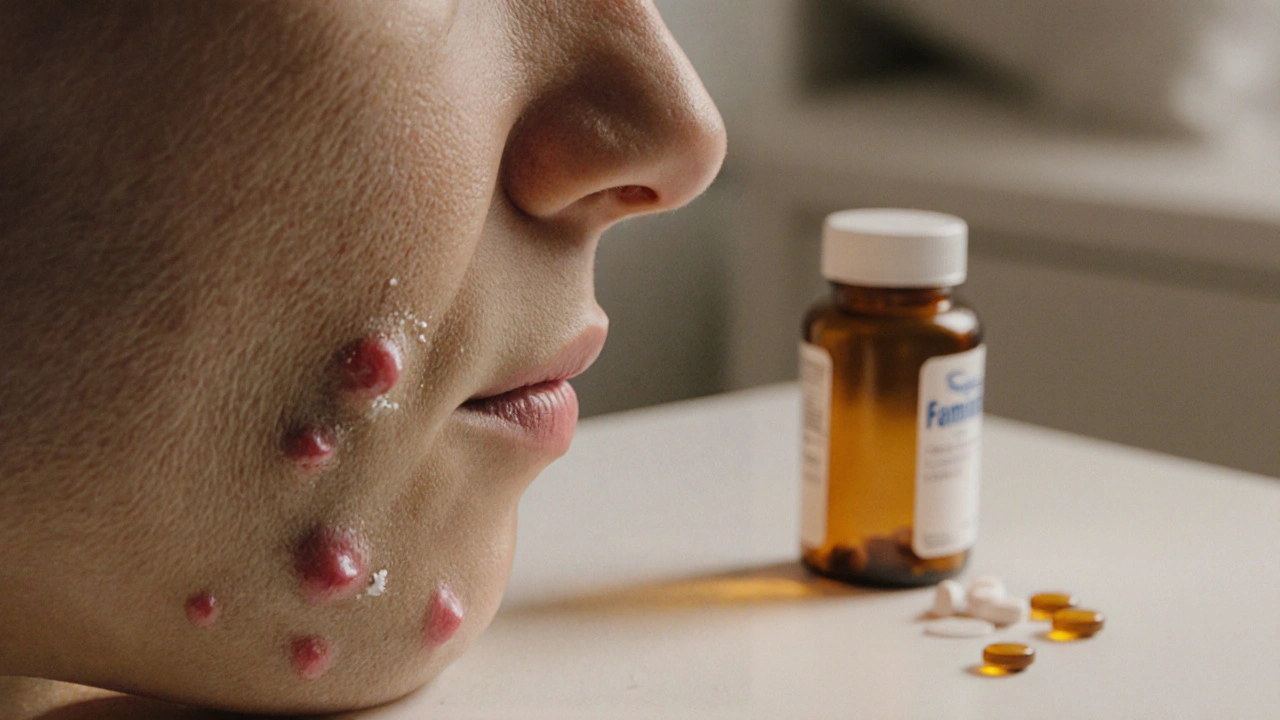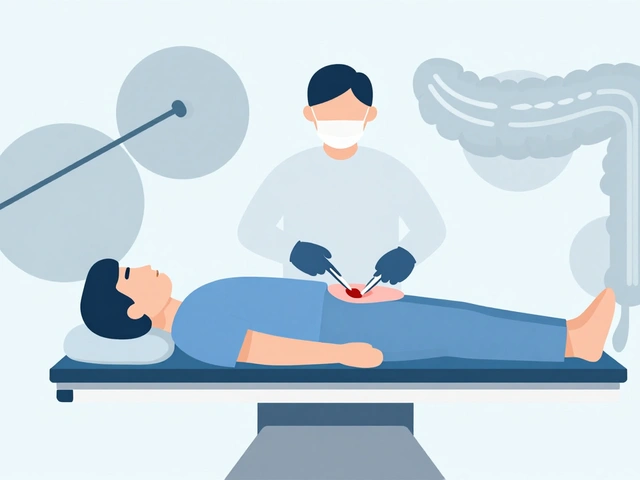Antiviral Treatment Advisor
Find the Best Treatment for You
Select your condition and key factors to get personalized recommendations for antiviral medications.
Shingles (Herpes Zoster)
Severe rash with pain, often on one side of body
Cold Sores (Herpes Labialis)
Small blisters around mouth or lips
Mild
Early stage, few lesions, minimal pain
Moderate
Clear lesions, some pain, discomfort
Severe
Extensive rash, high pain, fever possible
Healthy kidneys
No kidney conditions or concerns
Mild kidney issues
Mildly impaired kidney function
Significant kidney issues
Moderate to severe kidney impairment
1 pill/day
Simplest dosing
2 pills/day
Balance of convenience & effectiveness
3 pills/day
Strongest antiviral effect
Topical cream
No pills needed
When a painful outbreak of cold sores or shingles strikes, you want relief fast and a treatment that actually works. Famciclovir is the active ingredient in the brand name Famvir, a prescription antiviral that targets the herpes family of viruses. But it isn’t the only option on the market, and the right choice depends on how quickly you need results, how often you experience flare‑ups, and what your insurance will cover. This guide walks through the most common alternatives, side‑by‑side dosing schedules, cost factors, and safety notes so you can decide which drug fits your life.
Why People Choose Famciclovir
Famciclovir is a prodrug that converts into penciclovir after ingestion, allowing higher intracellular concentrations and a longer half‑life than some older antivirals. The typical adult dose for shingles is 500mg three times a day for seven days; for genital herpes it’s 250mg three times a day for five days. Its main selling points are:
- Convenient three‑times‑daily dosing (often less frequent than acyclovir)
- Effective at both the early and later stages of an outbreak
- Good data supporting reduced post‑herpetic neuralgia when started early for shingles
However, it requires a prescription, and the price can be higher than older drugs, especially without insurance.
Top Alternatives to Consider
Below are the most widely used antivirals that clinicians compare against Famciclovir.
- Acyclovir is the first‑generation oral antiviral approved in 1982, known under the brand name Zovirax
- Valacyclovir is a prodrug of acyclovir that offers better bioavailability, marketed as Valtrex
- Penciclovir is a topical cream (Denavir) used for cold sores; its oral form is the active metabolite of famciclovir
- Docosanol is an over‑the‑counter topical agent (Abreva) that inhibits viral entry, not a true antiviral but often listed as an alternative for mild episodes

Side‑by‑Side Comparison Table
| Drug | Brand | Formulation | Typical Adult Dose | Approval Year | Key Advantages | Common Side Effects |
|---|---|---|---|---|---|---|
| Famciclovir | Famvir | Oral tablet | 500mg TID for 7days (shingles) | 1994 | Longer half‑life, fewer daily pills | Headache, nausea, fatigue |
| Acyclovir | Zovirax | Oral tablet / suspension | 800mg five times daily for 7‑10days (shingles) | 1982 | Well‑established, cheap generics | Kidney irritation, diarrhea, rash |
| Valacyclovir | Valtrex | Oral tablet | 1g TID for 7days (shingles) | 1995 | Twice‑daily dosing for many indications | Headache, nausea, abdominal pain |
| Penciclovir (topical) | Denavir | Cream 1% | Apply 5times daily until lesion heals | 1996 | Directly targets lesion, minimal systemic exposure | Local itching, mild burning |
| Docosanol (topical) | Abreva | Cream 10% | Apply 5times daily within 48h of symptom onset | 2000 | OTC, safe for most ages | Mild skin irritation |
How to Pick the Right Drug for Your Situation
Every antiviral has a sweet spot. Use the checklist below to narrow down the choice:
- Speed of onset matters. If you catch the outbreak within 24hours, a topical like penciclovir or docosanol can halt the virus at the skin level.
- Frequency of dosing. For busy professionals, fewer daily pills (famciclovir or valacyclovir) improve adherence.
- Severity of infection. Shingles affecting the torso often needs a stronger systemic agent-famciclovir or valacyclovir are preferred.
- Kidney health. Acyclovir is cleared renally; patients with reduced kidney function may need dose adjustments or a different drug.
- Insurance coverage. Many plans treat acyclovir as a generic tier, keeping out‑of‑pocket costs low, while famciclovir can be pricier.
When in doubt, talk to your prescriber about how these factors intersect with your medical history.
Cost Snapshot (U.S. retail, 2025)
Prices fluctuate, but here’s a ballpark for a typical 7‑day course:
- Famciclovir 500mg tablets - $60‑$80 (brand) vs. $35‑$45 (generic)
- Acyclovir 400mg tablets - $10‑$15 (generic)
- Valacyclovir 500mg tablets - $30‑$45 (generic)
- Topical penciclovir cream - $45‑$55
- Docosanol cream - $12‑$16 (OTC)
For patients without insurance, the OTC option may be the most affordable, but it works best only for mild cold‑sore episodes.

Safety and Drug‑Interaction Highlights
All antivirals share a similar safety profile, yet there are a few nuances.
- Famciclovir. Rarely causes blood‑count suppression; monitor CBC in long‑term suppressive therapy.
- Acyclovir. Can precipitate crystals in the renal tubules; keep well hydrated.
- Valacyclovir. May increase serum creatinine; dose‑adjust in chronic kidney disease.
- Topicals. Generally safe; watch for allergic dermatitis.
Both famciclovir and valacyclovir are metabolized by the liver, so avoid combining with strong CYP3A4 inhibitors (e.g., certain antifungals) without medical guidance.
Frequently Asked Questions
Can I switch from acyclovir to famciclovir during an outbreak?
Yes, a switch is possible, but you should start the new drug within 24‑48hours of symptom onset for optimal effect. Talk to your doctor to get the right dosage.
Is famciclovir safe for pregnant women?
Animal studies show no major teratogenic risk, but human data are limited. Most clinicians reserve famciclovir for pregnant patients only when benefits outweigh potential risks.
How quickly does famciclovir reduce pain from shingles?
Patients who begin treatment within 72hours often report noticeable pain relief within 3‑5days, and the risk of post‑herpetic neuralgia drops by about 30%.
Do I need a prescription for docosanol?
No, docosanol is sold over the counter in most pharmacies. It’s a good first‑line option for mild cold‑sores if you catch the outbreak early.
What should I do if I miss a dose of famciclovir?
Take the missed dose as soon as you remember unless it’s almost time for the next one. Then skip the missed dose-don’t double up.
Bottom Line
If you value fewer daily pills and want solid protection against post‑herpetic neuralgia, famciclovir remains a strong candidate. For budget‑conscious patients or those with mild recurring cold sores, acyclovir and the OTC topical options often get the job done. Always weigh dosing convenience, kidney health, and insurance coverage before settling on a regimen.







James Lee
October 12, 2025 AT 02:03Ah, the endless parade of antiviral hype-one might argue the very notion of “best” is a philosophical illusion, definatly a construct of market engineers. The author curiously pares down the pharmacopeia to a tidy little table, as if life’s complexities could be summarized in a spreadsheet. Yet, the nuanced interplay of renal clearance, patient adherence, and socio‑economic shackles remains woefully under‑explored. One could elevate this discourse by invoking the Aristotelian concept of telos: the ultimate purpose of a drug is not merely symptom suppression, but the restoration of a flourishing life. In short, the piece serves as a competent primer, but it lacks the gravitas required for true medical enlightenment.
Dennis Scholing
October 23, 2025 AT 20:55Thank you for the comprehensive overview of antiviral agents. The inclusion of dosing regimens, cost considerations, and safety profiles provides a well‑rounded foundation for clinicians and patients alike. It is particularly helpful that the table delineates renal considerations, as dose adjustment remains a frequent clinical challenge. Moreover, the discussion of post‑herpetic neuralgia underscores the importance of early intervention with famciclovir. I would recommend adding a brief section on drug‑drug interactions, especially with CYP3A4 inhibitors, to further enhance the article’s utility.
Kasey Lauren
November 4, 2025 AT 15:46This guide makes picking a pill feel way less stressful!
joshua Dangerfield
November 16, 2025 AT 10:38Reading through the side‑by‑side comparison, I can’t help but feel a sense of relief that there are options beyond the old‑school acyclovir. The author rightly points out that dosing frequency can be a make‑or‑break factor for many busy folks. It’s also worth noting that the topical agents, while milder, can be a game‑changer for those who catch a cold‑sore early. I’d love to see a quick decision tree to help match severity with the appropriate medication. Keep up the solid work!
Abhimanyu Singh Rathore
November 28, 2025 AT 05:29Wow!!! This article is a masterclass in clarity; the tables sparkle, the bullet points sing, and the prose flows like a river of gold! The author has truly captured the essence of antiviral therapy-balancing efficacy, convenience, and cost-a triad that many overlook. I especially appreciate the mention of post‑herpetic neuralgia, a detail that often fades into the background. The cost snapshot, with its precise dollar ranges, is a brilliant touch that grounds the discussion in real‑world concerns. Kudos for weaving together science and practicality in such an elegant tapestry!!!
Stephen Lewis
December 10, 2025 AT 00:20Indeed, the cost analysis adds a pragmatic layer that many guidelines neglect. While the clinical efficacy remains paramount, patients increasingly factor out‑of‑pocket expenses into their decision‑making. A brief note on insurance tier placements could further assist readers navigating formularies. Thank you for highlighting this valuable perspective.